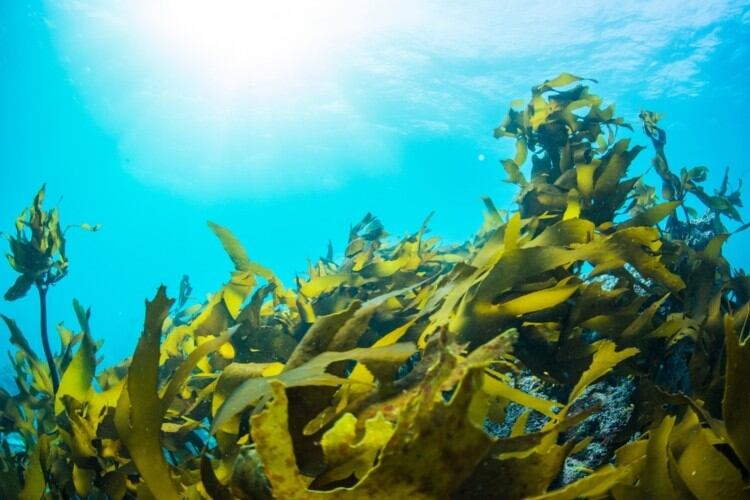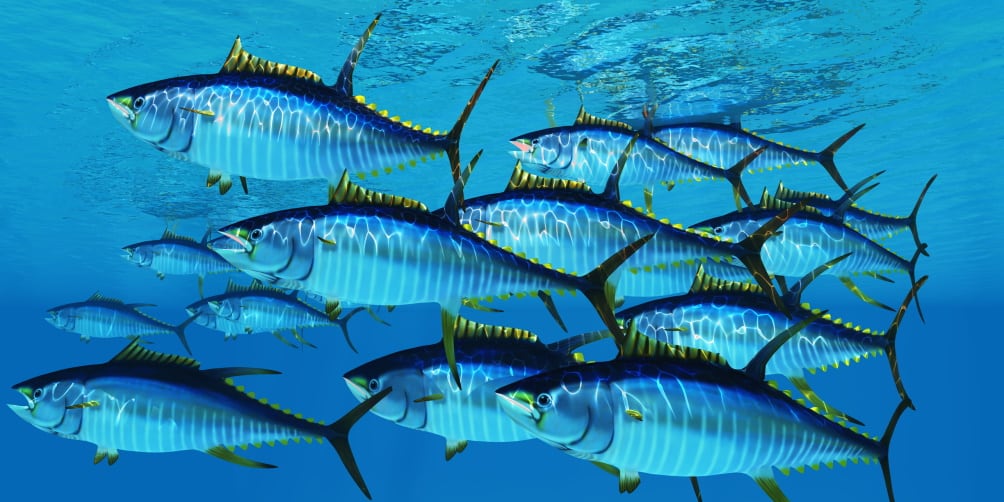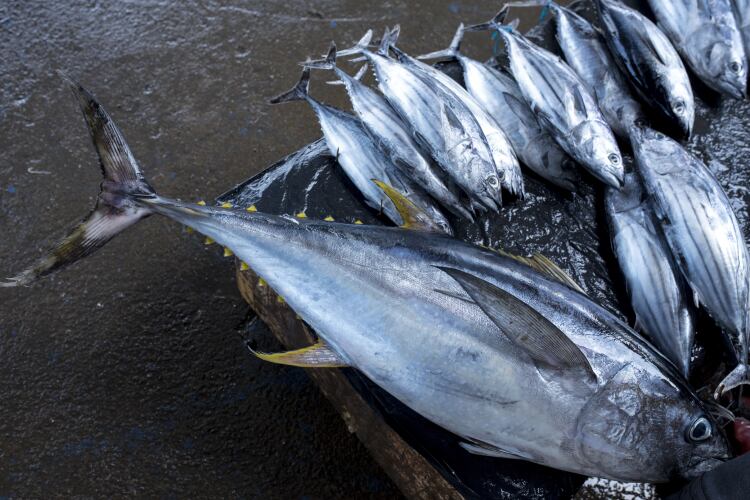Seafood is the largest traded food commodity in the world. Globally, around three billion people rely on wild-caught or farmed seafood for their main source of protein, figures from WWF reveal.
Marine stocks are, however, under threat. The UN’s Food and Agricultural Organization already estimates that 85% of fish stocks are fully exploited or overfished. And it isn’t just target species that are impacted by our hunger for seafood. The incidental catch of non-target species, the bycatch, sees many fisheries around the world discard more fish than they keep.
Global heating is also a danger to the stability of fish stocks. Since the 1970s, the oceans have absorbed 93% of the excess heat from greenhouse gas emissions. Over the past 30 years, scientists estimate that marine heatwaves have increased by more than 50%. These changes have far-reaching consequences for marine life, with higher temperatures and acidification already hitting marine habitats and species.
If climate change continues to impact the ocean environment, what does this mean for the future of sea life? That’s what a team of scientists from Dalhousie University in Canada set out to answer. Their recent evaluation of climate risks faced by nearly 25,000 marine species reveals that almost 90% will be placed at ‘high’ or ‘critical’ risk under high emissions scenarios to 2100.
“Our study evaluated the impacts of emissions on the climate risk for marine life – species and ecosystems. The results are unequivocal that emission mitigation is critical to reducing climate risk for species and ecosystems and avoiding widespread impacts on species, fisheries, ecosystem structure, biodiversity, and low-income coastal nations,” corresponding author Daniel Boyce, a research scientist at Dalhousie University, told FoodNavigator.

The researchers behind the modelling study, published in journal Nature Climate Change, hope their findings could help prioritise conservation efforts. By modelling the impact of geographical variation and habitat location on risk levels, they believe their findings can be used to rank the marine species and ecosystems at greatest risk in order to shape climate-oriented management strategies. The results, we were told, are ‘spatially explicit, reproducible, and communicated clearly on an absolute risk scale’.
“We calculated risk from 12 climate risk indicators that we evaluated at all locations where each of ~25,000 species are known to live. This approach can provide detailed information about which species are most at risk, where and when their risk is greatest, and how greenhouse gas emissions affect their risk. All this information helps us understand how to reduce the climate risk for species and ecosystems and develop effective conservation and management strategies for them,” Bryce elaborated.
How great is the threat?
Boyce and colleagues predicted the climate risk of 24,975 marine species worldwide, including animals, plants, chromists, protozoans and bacteria that inhabit the upper 100 metres of oceans.
Under high greenhouse gas emission scenarios (IPCC shared socio-economic pathway scenario 5-8.5), by 2100, almost 90% of the species are predicted to experience a high or critical risk of not being able to survive in their current habitat across an average of 85% of their geographical distribution.
The authors revealed one-tenth of the ocean has areas of combined high climate risk, endemism (where species are found in few locations) and extinction threat to species. The threat is greatest for larger predator species, especially those harvested for food such as species of pufferfish, tunas and sharks.
Changes would also hit the most vulnerable global communities hardest. “Our study suggests that continued high emissions could lead to widespread disruption of marine ecosystems, biodiversity and fisheries, with disproportionate consequences for low-income nations that have the least capacity to adapt. With continued high emissions, climate risks for fished species were systematically greater within the territory of low-income nations that tend to have a greater reliance on fisheries, a lower nutritional status, and lower food security. In a nutshell, while low-income countries have contributed the least to climate change and are the least well positioned to adapt to adverse climate impacts, they also have the highest climate risk to their marine fisheries and ecosystems,” Boyce observed.

In contrast, the climate risk for fished species in wealthier nations, many of which are in more northerly climates, was systematically lower. For instance, looking at high emissions scenarios, the proportion of species at high or critical climate risk was under 30% for high-income northern nations such as Iceland, Norway, Denmark and Canada. It was over 90% for many low-income nations that are situated at lower latitudes.
“This ongoing gap between those who have produced the most emissions and those who suffer the most from the impacts is an inequality that requires urgent attention,” Bryce stressed.
Emissions mitigation ‘critical’
These low-income nations stand to benefit the most from emissions mitigation, which will be vital to safeguard the future health of oceans globally.
“Emission mitigation is critical to reducing climate risk for species and ecosystems. The oceans are critical to our well-being. We depend on them for food, livelihoods, clean water, and oxygen production; they're important to our culture and sense of place. Reducing climate risk is essential to maintaining sustainable fisheries and a healthy ocean, and limiting the rise in ocean temperatures is the most straightforward path to achieving this.”
Mitigating emissions (under an SSP1-2.6 scenario) by 2100 could reduce the risk for nearly all species examined, enhance ecosystem stability and disproportionally benefit food-insecure populations in low-income countries, the team predicted.
“Any mitigation reduction approach needs to occur now and be multi-faceted. This will involve phasing out fossil fuel use and increasing renewables, moving towards a more efficient, circular economy, and developing technologies such as carbon capture,” Bryce told this publication.
At the same time, Bryce told us that the realities of climate change mean that adaption strategies also need to be developed. “While reducing emissions, we also must simultaneously develop climate adaptation strategies to ensure that our conservation and management approaches are effective under climate change. Our study can contribute to this. By understanding which species and ecosystems are most at risk and where and when their risk is greatest, we can more effectively conserve and manage marine life under climate change.”
Source
'A climate risk index for marine life'
Nature Climate Change
DOI: https://www.nature.com/articles/s41558-022-01437-y
FoodNavigator will be spotlighting the relationship between climate change and the food system at the upcoming Climate Smart Food broadcast event (20-22 October).
Our line-up of more than more than 40 experts will discuss how the food industry needs to adapt to the changing climate and reduce its GHG footprint in order to minimise impact. We'll be bringing together stakeholders from across the food system, ranging from NGOs like WWF to food corporates like PepsiCo and Mars, to answer some of the most pressing challenges facing the industry today and asking whether food production can be part of the climate fix.
The three-day broadcast event is free to attend. Register your interest HERE.

